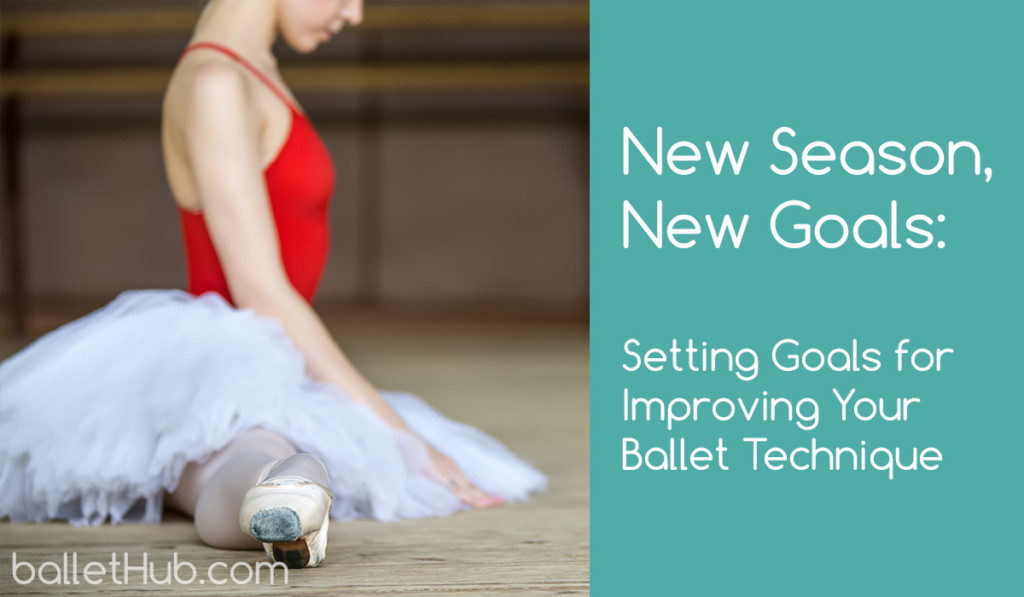Very often, we think of the typical year running from January through December. Around the end of December, many people make “new year resolutions” that typically revolve around some sort of goal; maybe to exercise more, finally clean out a room and have a yard sale, volunteer at a local charity or humanitarian cause, or start working toward a new career.
However, dancers often think of the year as a season or school year that runs typically between September to May of the following year. With the new season coming up, why not think of some “new year resolutions” or better yet, goals.
There are many reasons why you should start the new season with some personally created goals. The key here, is of course, “personally created.” The idea is that you are able to identify things you would like to see improved in your dancing. This may be more difficult for beginners, but especially beginning at intermediate levels where you’ve got a good grasp on technique, this can be very beneficial!
Here are some steps to consider following on your path to accomplishing your new goals for the year:
- Asses your current technique, performance, [thing you want to improve]. What do you think is the most lacking in your technique? Remember, much like a chain, your technique is only as strong as its weakest aspect. Think about the basics, like straight knees, lines, flexibility. Your goals may sometimes be the things you enjoy the least, but know you should work on them.
- Create a couple attainable, long term goals. Where do you see your technique in about 8 months? While it’s important to set high standards, they must also be reasonable. For example, if you’re just barely to do a double pirouette, try to consider getting just a clean double, at most, triple, by the end of the season. Going from an unpredictable double pirouette to nailing five ending on a balance every time usually doesn’t happen in a few months, and that’s to be expected. Ballet isn’t easy, so don’t make your goals impossibly hard.
- Create many, short term goals. Now that your long terms goals are established, how are you going to get there? These are your short term goals that are best to achieve month-by-month. For example, if your arabesque could use improvement, what will help improve it besides doing arabesque over and over and over? (Don’t say just trying to wack your leg higher!) Possibly working on a straighter legs, or not opening your hip too much? Or maybe your grande allegro could use some height, so working on grande battements could help. Identify these related short term goals and they will help with your long term. If you need help figuring out how to improve something specific, ask your teacher. A knowledgeable teacher will always have something to say.
- Create your plan of action. With goals in mind, consider your plan of action for these goals. What is the time commitment for them? Are you taking enough classes? Can some of them be worked on at home? Taking more classes can become an issue and you certainly don’t want to over due it, or may be limited by offerings at your school. However, stretching can be done almost anywhere! So can exercises using a strengthening band. These two things can help immensely, without even stepping foot near a dance studio. If they can help you achieve your goals (and they most likely will, no matter the technique-related goal), then how many hours do you think per week you should dedicate to these exercises?
- Execute and stick with it! As you start your year, actually start your goals! As you progress through your year, remember your goals! How important a goal is to someone is usually shown by them actually starting it and how they stick with it. “New year resolutions” have a specifically bad reputation for this. How often have you heard someone enrolling at a nearby gym for their “get fit!” new year’s goal, only to hear a year later how they’ve been twice, and one time every elliptical was being used? Or maybe never even went to the gym at all? Don’t let your goals become just words or hype. Starting and sticking to your goals is the only way to possibly achieve them.
- Stop for a moment and take stock. Let’s say you’ve been working on this step or that step, working on straighter legs, or higher and proper extension… Remember to stop a moment and evaluate. It’s called taking stock in your work. Where has this extra work, or plan of action gotten you after some amount of time? Be honest with yourself and be reasonable. Try to do this roughly every 3-4 weeks. Reason being is simply because, well, ballet is hard. It is very difficult to see measurable improvement in just a week’s time, and by evaluating your progress too early, it is easy to get discouraged or disillusioned. However, if after several weeks of honest work, and you don’t see improvement, maybe reconsider your efforts. Again, it’s helpful to ask a teacher, simply saying “I’ve made it a goal to improve my [insert ballet thing here], and I’m unsure about how it’s working out. What do you think I may be doing wrong, or am doing right?”
- End of the season already? Time flies when you’re having fun, and if you’re truly passionate about ballet, working toward improving your ballet technique is fun. In fact, “it isn’t work!” as the saying goes. So as the season starts, before you know it, it will have passed. Again, time to asses your technique. Did you meet your goals? What seemed to work well? What didn’t seem to work well? Did you partially meet your goals? Answering these questions can help you form better goals and plans of action for the coming seasons or other adventures you pursue.
- Celebrate! Then rinse, and repeat from step 1. If you’ve put forth your honest, best effort, celebrate and pat yourself on the back! After all that great work, why not? Sticking with goals is very difficult and many people will tell you how quickly they are abandoned (see above, going to the gym). So be happy with the accomplishment that you’ve, at the very least, stuck to what you said you were going to do. And if you had a good plan of action, it’s very likely you can see improvement. It’s okay if you didn’t accomplish all of your goals, because now maybe you’ve realized it’s about the process. Just think, if you always met every single one of your goals at the exact time you thought you would, there may be a chance you aren’t setting them high enough! So if you don’t meet all of them, no worries, take a breath, and start again at step one.
Getting discouraged with your ballet technique and goals?
It is very important to remember not to get discouraged. I know, easier said than done: We all have bad days where it seems any effort is pointless. But you either let those tough days get the best of you or you dust yourself off and move forward. Sometimes you just may need to revamp your plan when you stop to take stock. It’s okay to change goals because you’re re-evaluated, but you should never completely give up on the idea of achieving a goal. After all, think about life after ballet. Will you go from being goal oriented to just doing nothing? It’s very unlikely.
I mentioned above a little about partially meeting your goals and I am certainly in that camp. I would often be on the ambitious side and try to improve many things, and naturally, some things took precedence over the others. So this resulted in me wanting to “improve my back double carbriole” for about five years straight, never quite seeing much improvement. But in that meantime, I felt my technique in other areas had improved quite a bit. So was my effort wasted even though my cabriole goal never got met? Of course not!
Lastly, remember everyone improves at different speeds, and it isn’t always consistent since there are many variables involved. One week, you may feel stellar, while the next, you feel you’ve lost it all. Regardless, you must always remember this fact: Ballet is not easy! Knowing ahead of time that it won’t always be smooth sailing can often prepare you so you aren’t affected or derailed. Remember, if ballet was easy, you wouldn’t need to be setting goals in the first place. Use this as encouragement and reason, set goals, then work both hard and smart!
While this article is titled and presented with setting goals at the beginning of the year, don’t let mid-year inspiration stop you. Whether it’s January 1st, September 1st, or a random day in the summer, you can create goals for improving your ballet technique, or any aspect of your life of course, and start working towards them.

